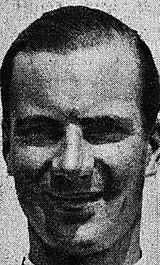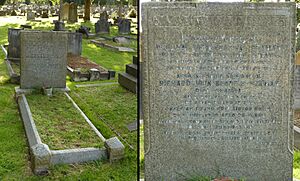Richard Seaman facts for kids
Quick facts for kids Richard Seaman |
|||||||
|---|---|---|---|---|---|---|---|

Seaman, circa 1939
|
|||||||
| Born | Richard John Beattie Seaman 4 February 1913 Chichester, West Sussex, England |
||||||
| Died | 25 June 1939 (aged 26) Spa, Liège, Belgium |
||||||
| European Championship career | |||||||
| Years active | 1935–1939 | ||||||
| Teams | Scuderia Torino, Mercedes-Benz | ||||||
| Starts | 7 | ||||||
| Championships | 0 | ||||||
| Wins | 1 | ||||||
| Podiums | 2 | ||||||
| Poles | 1 | ||||||
| Fastest laps | 2 | ||||||
| Champ Car career | |||||||
| 1 race run over 1 year | |||||||
| Best finish | 6th (1937) | ||||||
| First race | 1937 Vanderbilt Cup (Westbury) | ||||||
|
|||||||
Richard John Beattie Seaman (born February 4, 1913 – died June 25, 1939) was a British racing driver. He raced for the famous Mercedes-Benz team from 1937 to 1939. He drove powerful cars like the Mercedes-Benz W125 and W154. Richard won the 1938 German Grand Prix, which was a huge achievement. Sadly, he died from injuries after his car crashed at the 1939 Belgian Grand Prix.
Contents
Richard Seaman's Early Life
Richard Seaman was born into a rich family in Aldingbourne House near Chichester, Sussex, England. His parents were William John Beattie-Seaman and Lillian Seaman. From a young age, Richard loved cars and driving.
He went to Rugby School and then to Trinity College, Cambridge. While at Cambridge, he first tried racing at the 1931 Shelsley Walsh Speed Hill Climb. His parents hoped he would become a Member of Parliament (a politician) or a lawyer.
While at Cambridge University, Richard and a friend flew to South Africa. He also often traveled around Europe with his family. In 1933, his family bought a large house called Pull Court in Worcestershire for him to inherit. In 1934, he decided to become a professional racing driver. He took his MG car to Europe to get more racing experience.
Richard Seaman's Racing Career
Starting Out in Racing
Richard Seaman started his racing career with great success. He won the "Voiturette" race (a type of smaller car race) at the Swiss Grand Prix on his very first try. He then won it three times in a row! He also won other smaller races for English Racing Automobiles (ERA) at places like Brooklands and Donington Park.
A talented Anglo-American driver named Whitney Straight was Richard's friend and helped him a lot when he was starting out. Richard even competed in the Mont Ventoux Hill Climb because Straight encouraged him.
In 1935, Richard had a very good year with ERA. He started in the pole position (the very front) at the 1935 Dieppe Grand Prix. He also won the junior category of the 1935 Coppa Acerbo race. By 1936, he was focusing more on big Grand Prix races.
Richard was very successful in 1936, both in the UK and in Europe. He used a special 1926 Delage race car that was almost unbeatable with him driving it. He won the British Empire Trophy in 1936 at Donington Park in an ERA car. Richard also won the 1936 Donington Grand Prix in a Delage, sharing the win with Swiss driver Hans Rüesch.
He also did well in many hill climb events. In 1936, he won his class at Freiburg, finishing only one second behind the overall winner, Hans Stuck.
Eventually, the team boss for Mercedes, Alfred Neubauer, invited Richard to try out for their team at the Nürburgring track. Big teams like Mercedes often had at least one driver from another country.
Richard had his last race in a Delage car at the 1937 South African Grand Prix. He had to stop early in that race.
In 1937, Richard signed a contract to race for Mercedes-Benz. His mother was not happy about this because she didn't want him to drive for a "Nazi" team. The Mercedes cars were part of a racing program supported by the German government. These cars were much faster, better built, and more reliable than any cars he had driven before. This gave him a chance to win major Grand Prix races and become one of the best drivers in Europe.
Racing in 1937
Richard Seaman's start with Mercedes in the 1937 Grand Prix Season was tough. He was involved in a serious accident at the 1937 German Grand Prix where another driver, Ernst von Delius, sadly died. Richard's injuries from this crash stopped him from racing in the next few events.
However, he finished fourth at the 1937 Italian Grand Prix and again at the 1937 Czechoslovakian Grand Prix. His team boss, Neubauer, made Richard a reserve driver for the 1937 Swiss Grand Prix, which disappointed him. Outside of Europe, Richard finished second in the Vanderbilt Cup race in the United States.
Racing in 1938
Richard got even better during the 1938 season. He won the 1938 German Grand Prix, which was the most important race for the German teams. He became a favorite driver of Adolf Hitler. This win was special because it was the first time a British driver had won a major European Championship race since 1923.
After his win, Mercedes kept Richard as a reserve driver for a short time. When he returned, Richard started from pole position and finished second at the 1938 Swiss Grand Prix. This was at Bremgarten, his favorite track. He also finished third at his home Grand Prix at Donington Park. His friend and writer, George Monkhouse, said Richard's drive at the Swiss Grand Prix, in very wet conditions, was the best of his career.
1939 Season and His Death
Richard Seaman had a slow start to the 1939 Grand Prix season. He went to the 1939 French Grand Prix but didn't race. His team boss also didn't let him race at the Tripoli Grand Prix. He competed at the 1939 Eifelrennen race but had to stop early because of a broken clutch.
During the 1939 Belgian Grand Prix at Circuit de Spa-Francorchamps, it was raining. Richard was leading the race when, on lap 22, he crashed his car into a tree. People think he might have been driving a line through the corner that was only safe in dry conditions. After the crash, the car caught fire with Richard still inside.
Richard died a few hours later from his burns. This was the only time a Mercedes driver died during a race in that period. On his deathbed, Richard told Mercedes' chief engineer, "I was going too fast for the conditions – it was entirely my own fault. I am sorry."
After Richard's death, Mercedes-Benz stores around the world were told to display his photograph. Richard Seaman was buried at Putney Vale Cemetery in London. A special stone was put up at Spa-Francorchamps to remember him, but it later disappeared.
Richard Seaman's Personal Life
Richard had a difficult relationship with his mother, Lillian. She didn't like his choice to drive for a "foreign" team, especially one connected to the Nazi Party. Richard also became less fond of his home, Pull Court. This happened after he couldn't find enough local staff to help with a party he planned for his racing friends.
Richard spent most of his time between Worcestershire and London. He spent a lot of money on travel and enjoyed waterskiing.
As a wealthy person, Richard got along well with his fellow Mercedes teammates, Manfred von Brauchitsch and Rudolf Caracciola. They also came from rich German families.
In December 1938, Richard married Erica Popp. She was the daughter of the director of BMW. Again, his mother was against the marriage. Richard was 25 and Erica was 18. Her father bought the couple a home in Bavaria as a wedding gift.
After Richard died, Erica spent World War II in the UK and the U.S. She later got engaged to another racing driver, Reggie Tongue, but they never married. She married two more times and died in 1990 at age 69. She wore the engagement ring Richard bought her for the rest of her life.
Richard Seaman's Legacy
Richard Seaman is often seen as one of Britain's greatest Grand Prix drivers from before World War II. People tell stories about his connection to Pull Court. One story says that Richard's Mercedes Grand Prix cars are buried on the estate. Another story says his mother, Lillian Seaman, left the lights on at Pull Court during World War II to help guide German bombers.
His Mercedes teammate, Hermann Lang, wrote in his book that Richard was "kind-hearted, cool and fair as a sportsman, just as I had always pictured Englishmen to be."
Even though Richard just wanted to drive for the fastest team, no matter the politics, his connection to Nazism has made his legacy complicated. Richard privately admired Hitler. He also famously gave a Nazi salute after winning the 1938 German Grand Prix. Also, the largest wreath at Richard's funeral was sent by Hitler, even though Richard's family didn't want it.


